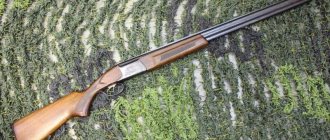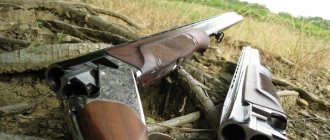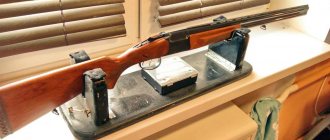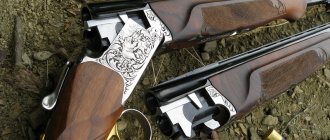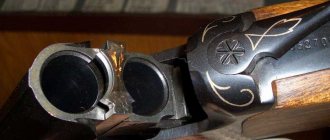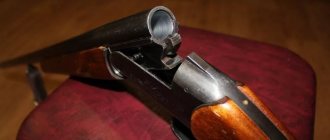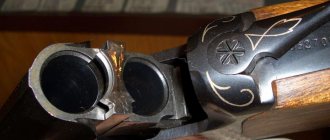The MTs-21-12 shotgun is the dream of every Soviet hunter, a legendary self-loading rifle for hunting. Created back in 1958 at the Central Design Bureau of Sports and Hunting Weapons, designer V.A. Nikolaev.
It has been mass-produced since 1965 at the Tula Arms Plant and is still in production today, although in the opinion of many it is an obsolete model.
The MC 21-12 is a single-barreled shotgun that was produced in different calibers: 12, 16, and 20. The most common is MC 21-12 in 12 gauge.
The gun was developed using Browning technology, a spring-loaded walking barrel moves due to recoil and a longitudinally sliding bolt, this is the automation and the basis for the uniqueness of this weapon for those years.
The gun is reloaded by moving the barrel back and forth.
Almost all elements of the mechanism, including the barrel bore, are chrome-plated, which makes the weapon easier to care for and ensures its durability. The barrel is removable, the length of which is about 750-760 mm.
The hammer-type trigger mechanism is made on a separate base. The cartridge case is removed by moving the barrel forward and to the rearmost position.
The magazine of this gun is tubular, under-barrel. Holds 4 cartridges. It also serves as a guide for the entire barrel.
The magazine is filled one cartridge at a time through the receiver window. There is also a cartridge cutter, which is located on the left side of the receiver.
The fuse is a flag fuse and has the properties of moving from the right side to the left, and vice versa. The disadvantage of such a fuse is that it is non-automatic, it simply does not allow you to pull the trigger.
Pistol shaped buttstock. The removable forend is secured with a spring-loaded nut.
History of creation
The history of the development of the semi-automatic MTs-21-12 dates back to 1958. At that time, a group of young enthusiastic engineers under the leadership of V. A. Nikolaev, a former designer of TsKIB (central bureau for the creation of sports and hunting weapons), began to develop fundamentally new models of hunting weapons with unique systems. One of the most successful projects was the MTs-21-12 shotgun, which uses a powder gas exhaust system to release the spent cartridge case from the chamber and also feed new ammunition into the barrel.
The appearance of such a unique weapon on the Soviet market did not leave the public indifferent. Professional hunters and gunsmith experts compared the new gun from TOZ with the legendary German Browning. However, the first batch did not receive good reviews, since the MTs-21-12 had several flaws. For example, many owners complained that the model is incompatible with folder sleeves. Therefore, for the next few years the company was diligently modernizing the existing model. Only in 1965 the final version was released, devoid of most of the shortcomings. Subsequently, TOZ began developing the MTs-22-12.
Loading ammunition at home
Unfortunately, today the cost of even domestic ammunition leaves much to be desired. The cheapest 12-gauge cartridge in 2022 costs no less than 25 rubles apiece, which is why most hunters prefer so-called rolling papers, purchasing them second-hand or making them themselves. Such a process does not require any serious knowledge and skills from you. The only thing you need is to purchase a special machine for pressing gunpowder and rolling cartridges, and also acquire a pharmacy scale.
During the process of creating your own cartridges, you will need to maintain the optimal ratio of gunpowder and shot, which is shown in the table below. As an example, we took Sokol brand gunpowder and number five shot.
| Powder to shot ratio | Gunpowder in grams | Fraction in grams |
| 15,8 | 1,9 | 30 |
| 14,7 | 1,9 | 29 |
| 15,5 | 1,8 | 28 |
| 15,0 | 1,8 | 27 |
| 15,3 | 1,7 | 26 |
Remember that even the slightest error in measurements can lead to dire consequences, so use high-quality electronic scales, checking their functionality in advance with some weight or object whose exact weight you probably know.
Design and principle of operation
The design and the entire operating principle of the MTs-21-12 is based on a powder gas recoil system, as well as a long barrel stroke. The process is supported by several hinges and springs, and pins and couplings are used to secure the parts. To understand exactly how this complex system works, it is necessary to study in detail what happens during a shot:
- The shooter pulls the trigger. The firing pin hits the cartridge primer. The combustible mixture in the cartridge case ignites, resulting in a strong energy that acts on the bullet and pushes it out of the barrel.
- Part of the energy enters the barrel branch. As a result, the springs are compressed and the bolt frame moves. The shutter window opens and the spent cartridge case is ejected from the chamber under the action of the extractor.
- A new chamber is fed from the magazine. This happens because the ammunition in the container is constantly under the action of a spring. Once the chamber becomes empty and it opens, the top cartridge falls into the barrel.
- The shutter closes. After the new ammunition enters the barrel, the bolt spring will relax again and the cover will return to its original position. This will trigger the barrel locking mechanism and activate the safety.
Now that the basics are understood, and the principle of operation of semi-automatic weapons is clear, we can talk about other parts of the weapon design. Here is a list of just those systems and mechanisms that distinguish the MTs-21-12 from other smoothbore guns:
- The presence of a non-automatic flag-type fuse. It is directly connected to the trigger, so the shooter will not be able to fire a shot until he moves the lever to the firing position.
- Wooden stock and pistol grip. Both parts are made of beech or walnut. The stock is lightweight, but has a cheek rest for greater ergonomics, as well as a thick rubber butt pad to absorb recoil.
Stock and fore-end for MTs-21-12, walnut
- Movable barrel with quick release system. If desired, the owner of the MTs-21-12 can very quickly remove the metal part by simply unscrewing it from the thread in a counterclockwise direction. The chamber remains in place.
As for the trigger, in general its design is standard, but it has improved build quality, since the powder energy can lead to instability of parts. As an addition, we can consider an extractor, which serves to eject the spent cartridge case at the moment when the bolt is in the forward position.
MAKSIMOV.SU
Photo by the author
and Evgeny Rozhkov The hero of our article, the MTs 21-12 gun on the cover of the Master-Ruzhye magazine. from the collection of Evgeny Rozhkov was used for photography
The Tula rifle MTs21-12 was known to almost every Soviet hunter.
It was expensive - in the souvenir version up to 580 rubles (with an average salary of 140 rubles), it was always scarce and prestigious. The “Pyatizaryadka” had a soft recoil and excellent fire action, provided by the internal profile of the conical barrel with a constant short choke. There were also problems with reliability, due to the design features of the serial gun and the final quality of processing of the mechanism parts.
In the 1990s,
when a muddy stream of imports poured into the new Russia, the well-deserved “emtseshka” was relegated to the background in the minds of domestic hunters. Then new self-loading devices of domestic design appeared. Which, simultaneously with the restructuring of TOZ’s activities, finally put an end to the “Soviet Browning”.
But
the operational features of this Tula gun, combined with its low price on the secondary market and the nostalgic factor, led to a revival of interest in the MTs21-12. Today we can say that all the problems of this model have been thoroughly analyzed.
Owners of MTs21-12,
those turning to the works of Wolf, Vdovenko, Azarov, Ishkhneli and other respected hunters could not help but be concerned about questions regarding their weapons. Why can two different guns using the same cartridges have completely different recoil? Why does one gun work uninterruptedly, while another constantly or periodically gives a poorly understood delay without identified defects and operational wear of the mechanism parts? At what weights of shells should the gun operate smoothly?
Let's omit
For now, there are questions about the principle of operation of the automation with the stroke of the barrel, the years of manufacture of the product, the quality of the “fitter”, assembly and loading of the cartridge (we will return to some questions below). Let's look at the main delays when shooting and the features of the gun's combat. So, this is the failure of the barrel to disengage from the bolt in the rearmost position after a shot, and, as a result, the gun jams.
Exactly
Because of this delay, gun owners were dubbed “motorcyclists” in the 90s, because. The easiest way out of the situation is to rest the gun with the butt on the ground and hit the bolt handle with your heel to bring it into working condition. The MTs21-12 could also “drop” cartridges under its feet and shoot with a strong upward movement of the shot scree.
Various options
solutions to problems have been repeatedly described by the above authors and are in available sources. We will consider the points that have not been given due attention. First, let's look at the history of the gun. Fast forward to 1958. Even then, the group of designers under the leadership of Nikolaev well understood that a gun weighing 3.6 kg was a hunting gun and should work reliably with the average “Soviet cartridge.”
Automatic shotgun
should work confidently with any cartridge suitable for use in any other Soviet hunting rifle.
MC21-12
was not intended for the use of sports cartridges and cartridges in brass and folder casings, which was subsequently directly indicated in the gun’s passport (here I note that back in the early 2000s, I repeatedly saw the use of old cartridges in a folder casing in the “emtseshka” - in in properly modified guns it “rolled”).
Let's consider
the conditions under which work on this design began. With instructions from above, Tula designers were given the task of creating a gun similar to the Breda Antares, which in turn was a descendant of the famous Browning Auto 5. Our gunsmiths needed to ensure excellent gun action and minimal recoil, typical for systems with a barrel stroke.
Wherein
it was necessary to “not fall under plagiarism” and avoid the need to purchase licenses and other permits for gun components and assemblies. The task was non-trivial, but it had to be done. And it was done.
Gun passport
The 1963 TsKIB SOO clearly demonstrates that, like the progenitor of the Browning Auto 5, the domestic gun was initially equipped with two barrel return springs of different lengths and stiffness: 240 mm for cartridges with a 32-35 gram projectile and 225 mm for charges from 24 grams The same passport also contains the following information: “The cartridges used in the process of checking the reliability of the gun ensured that the flight speeds of V0-2.5 shot shells were 350+10 m/s.
These cartridges
contained 35 grams of standard shot No. 7." For what reasons the gun later began to be equipped with one spring - no one can say now. Until about 1987, all MTs21-12 shotguns were equipped with a 240 mm long barrel return spring and an old-style brake with flutes, 22 mm wide. Agree that few hunters would voluntarily agree to run through the forest with almost four kilograms of iron in order to ultimately shoot a cartridge with a shot mass of 24 grams. There are other guns for this.
Nevertheless,
This capability was originally built into the MTs21-12, making it a universal weapon.
Any
a self-loading weapon is, in a simplified way, a kinematic chain. The MTs21-12 mechanism is not rigidly hinged, i.e. lever (as, for example, in LeverAction carbines, where the beginning of the movement of one link is immediately transmitted to the rest). The trouble-free operation of the Tula “self-loading” is mainly ensured by the calculated speed of recoil/rollback of the barrel. This speed is largely dependent on the setting of the gun's braking system for the cartridge used.
About this
features of the gun were pointed out by Wolf and Vdovenko, arguing that: “... in MTs21-12, designer Nikolaev relied on a powerful jerk of the barrel forward under the influence of a strong spring. But this doesn't always happen. After all, the brake collet sometimes moves tightly around the magazine, and the return springs of the barrel are short and weak. So the movement of the barrel is sometimes smooth. Short barrel return springs must be discarded. It is better to replace them with long springs, while also replacing the brake collets.
Narrow
modern collets need to be replaced with old-style collets with internal grooves and correctly installed brake rings. By the way, the reliability of the feed also depends on debugging the amplitude of the swing and the moment at which the feeder tray begins to move. However, it is better to entrust all this to other hands - a gunsmith. Illiterate, thoughtless filing can damage the gun so much that it will take a lot of effort to restore it. Gunsmiths therefore work more with a hammer than with a file...”
In semi-automatic weapons
The operation of the automation is mainly based on the “sweeping” movements of the moving system and the collision of parts, which, among other things, ensures the reliability of the automation.
Therefore, for example, the use of a recoil buffer and lightweight bolt frames in gas exhaust systems sooner or later leads to failures. The reliability of systems with a moving barrel also depends not only on the design and assembly, but also on the quality of the components. Which, in fact, is what the TOZ privates of MC 21-12 had problems with. This was often
aggravated by illiterate “finishing” of the gun. As a result, all this became the reason for the appearance of unflattering reviews and the formation of not the best image of the Tula “five-charger”.
Initially
In 12 gauge, the TsKIB SOO gun was chambered for the 12x65 cartridge, also in 16 and 20 gauge. But how to ensure equal recoil while maintaining the same general dimensions of the gun for three different calibers? How to make a gun trouble-free if the barrel support ring is almost equidistant from the chamber for a four-round magazine? The impulses are different. The simplest option is to use different forces for complete closure of the working turns of the barrel return spring or move the “support” closer to the barrel cut.
But this option
will increase the mass of the already heavy gun, so that only the springs remain. It is well known that springs are calculated according to a certain algorithm and require a calculated landing geometry.
For a comfortable shot
in calibers 16x70 and 20x70 of this geometry, i.e. The distance around the magazine in the assembled gun from the box to the buffer was sufficient in terms of “stiffness” (the force required to completely close the working coils). But for 12x65 - no longer, because... the calculated spring simply did not fit into the gun.
Eventually
The return spring for caliber 12x65 was made at the peak of the permissible geometry, ensuring long life without critical shrinkage of the spring in sizes of 20 turns, with a length of 240 mm and a wire diameter of 3.1 mm. This diameter, after hardening with steel shot, “compressed” to 3.07 mm.
Maybe,
a good solution when switching to 12 gauge would be to use two springs simultaneously in the brake system - long and short, of different stiffness, using a double-sided thrust “glass” moving around the magazine. Such a scheme was implemented in the rifled Remington Model 8 back in 1900. But this inevitably led to the purchase of US Patent 659.786, which was unthinkable in 1958.
Only Russians
With such restrictions, they can squeeze a working 12-gauge gun into the size of a 16-gauge shotgun. For example, the 12-gauge Breda Antares has a shorter bolt and barrel travel, but the barrel return spring wire has a larger diameter - 3.2 mm, and the spring itself is stiffer. In the MTs21-12 such a spring will not fit - the barrel and the internal cavity of the forend are in the way. However, wire with a diameter of 3.0 mm does not provide adequate survivability without shrinkage. In terms of force and dimensions, the optimal wire for 12 gauge was a wire with a diameter of 3.1 mm, but there was no such GOST in the USSR.
roll
making it from 3.2 mm wire would be too expensive, so springs for serial TOZ shotguns began to be made from wire with a diameter of 3.0 mm. With further processing of the gun for the 12x70 cartridge case, this criticality only intensified. It would probably be better to leave the gun in 16 gauge then...
If
approach hunting from a classical position, then 12 gauge and, especially, its “magnum” variants can be called a dead-end path imposed on us. For Russian conditions, if there is a 16-gauge, there is no need for either a 12- or 20-gauge. Thirty grams of shot at speeds of 380 m/s is enough to kill any game at reasonable distances, just select the shot correctly. The same 12-gauge Polev bullet without a container is essentially a 16-gauge bullet.
Americans
They shoot with steel shot, which is a consequence of the obsession with “conservation of nature.” This required high speeds, because All other things being equal, steel shot is inferior to lead in terms of lethality. Thank God, this does not threaten us yet. Only the Americans have had high-velocity, low-pressure gunpowder for about 15 years now, but we... let’s just say, it’s not so great yet.
In Group
The designers of the MTs21-12 were venerable ballistic specialists, which predetermined a number of technical features of this self-loading gun. The gun was originally made for long-range shots with only two “bird-hare” shot - No. 3 and No. 7. Simply put, there are only two consistent shot numbers for this barrel. Which, however, covered almost all the needs of our hunter.
Unique
In its own way, the long-range capability of the MTs21-12 is ensured precisely by the internal profile of the barrel, but it does not in any way reduce the amount of gunpowder in the cartridge, which is reflected in the 1963 passport. The use of an “overdose” cartridge in the MC 21-12 creates conditions for delays and has a detrimental effect on the mechanism parts, sharply reducing the service life of the gun.
According to the technical specifications,
The MTs21-12 barrel was designed to be shot at distances up to 45-50 meters (!). This also partly explains the results of control mass shootings at 35 meters, when people complain about the over-inflated combat. May MTs21-12 not rise! It’s just that it was shot at a different distance and is not designed for speeds above 380 m/s.
Each MC21-12 is unique
Is there some more
There are a few things you need to know and understand. Firstly, two identical MTs21-12 shotguns do not exist in nature. Secondly, what can terrify a modern designer-technologist is that the geometric parameters of the mechanism of each gun are strictly individual, i.e. are not a constant value.
To such nodes
include: • protrusions of the bolt, barrel, stops and their relative position; • the depth of the groove in the barrel support ring (accordingly, the seat for the barrel return spring); • the distance from the forend holder facing the box to the textolite bushing of the forend; • brakes and buffers of the gun, their quantity (it has been experimentally proven that they allow you to remove up to 4.5 kg of force from the spring).
Any
The spare parts for the gun require individual adjustment.
Recommendations
Absolutely not
shoot from the MTs21-12 with the setting for complete closure of the turns of the barrel return spring, placing additional spacers, buffers and rings under it or increasing the number of turns by more than one. All this can lead to bending of the end coil of the spring at the rearmost point of the barrel after a shot and splitting of the forend. In addition, as a result, the spring will begin to shrink even more intensely (a progressive irreversible decrease in the free length).
Shooting
Only springs with a square cross-section are allowed to close coils without shrinkage. The brake system should always be lubricated. The gun has a stable fire rate at speeds of 350-380 m/s on cartridges with a pressure of 600-700 bar, although this can be considered a reproach towards modern cartridge manufacturers focused on modern guns with initial speeds over 400 m/s.
Right
the adjusted braking system makes the MTs21-12 faster-firing, increases the sharpness of the combat and reduces the upward drift of the scree due to less barrel toss.
Let's leave it behind the scenes
reasons for technological inconsistencies between TsKIB and TOZ guns in terms of brakes and buffers, because this difference is not critical for the operation of the gun (the brakes at TsKIB were milled, while the TOZ ones were stamped out), all sorts of rationalization “plates” on the bolts. This, as they say, is a thing of the past. Currently, TOZ, at the request of the customer, manufactures valves and springs of any parameters. But provided that the customer himself understands what exactly he wants.
Hunter,
Having been brought up with a disdainful attitude towards the MTs21-12, it is difficult to believe that this gun is capable of operating smoothly and with minimal recoil on any length of barrel return spring, depending on the individual preferences of the hunter regarding the characteristics of the cartridge. There is simply no need to mix these combinations into a “vinaigrette”, arbitrarily changing the speeds and amplitudes of the parts of the moving system. Then the likelihood of delays will be minimized.
Preferably
adhere to the design idea, which gives us the following ready-made recipes: • For a projectile weighing up to 32 grams, we need: a short barrel return spring (210-230 mm, with a force for complete closure of the working coils of 25.0-28.0 kg) and a new type brake , “smooth”, 12 mm wide; •For a projectile weighing more than 32 grams, you need: a long barrel return spring (237-243 mm, with a force for complete closure of the working turns of 31.5-34.0 kg) and an old-style brake with flutes, 22 mm wide;
Universal brake
for both options there is an old-style brake with a width of 16-19 mm.
About the barrel return spring
Currently
It is a great success for the owner of a gun to get an old Soviet barrel return spring with a length of 240 mm. As a rule, they already have operational shrinkage within the residual 236-238 mm. On sale there are only short (220-230 mm) products made in Izhevsk and Tula, which provide a comfortable shot with minimal recoil for cartridges with a small amount of shot.
Long springs
For reasons unknown to anyone, TOZ refuses to mass-produce them for sale and makes them only when repairing a gun at the request of the customer. As a result, most often you can only buy what is sold after the weapon is handed over for recycling.
Taking into account
conditions indicated above, it is extremely difficult to manufacture such a spring. Having no maneuver in the diameters of the wire, with limited overall geometry, the manufacturer needs to provide the spring with the proper rigidity and provide resistance to shrinkage. This requires high-quality alloy wire, and this is a problem throughout the entire territory of the former USSR. A full range of hardening is also needed, including operations with steel shot.
Attempts
To comply with all these conditions during the production of springs, attempts were made many times at various enterprises in Moscow, Brest, St. Petersburg, Krasnoyarsk, Novokuznetsk, Barnaul and Rostov-on-Don. But unsuccessfully. In another dozen cities, such technical specifications were simply immediately refused, citing the incompatibility of the calculations with the overall landing geometry.
problem
Only specialists from Kazan, who have been manufacturing springs of any complexity for about 20 years, were able to solve this problem empirically.
But even here
not without that same “pancake lumpy” - a defective batch of products due to “Ketai” wire, passed off by an unscrupulous seller as a premium product. Of course, the issue was resolved, but the specifics of the modern market taught many participants in this project a lesson.
Grease and oils
At the moment
During the creation of MTs21-12 there were no modern super-lubricants. Meanwhile, the gun worked properly. The “spindle”, well known in Russia, allows you not to change the lubricant all year round and regardless of natural conditions. Unless for a climate above minus forty, you need to choose a more fluid option.
To lubricate the gun
WD-40 cannot be used. This is not a lubricant, it is a “liquid key” that removes moisture. As a result, the gun becomes “dry” and delays begin. The use of gas-filled modern lubricants also does not lead to anything good. The volatile fraction quickly evaporates; on moving and rubbing surfaces, after a short period of work, the so-called. “soot plasticine”, which also provokes a malfunction of the automation. Do not fill the gun mechanism with lubricant.
Gaps
on the rubbing surfaces of the lug are very small, an overly lubricated lug will begin to “squelch”, which leads to the gun jamming.
Once again about the file
and the unpurchased patent
TOZ employees
The rank and file of the MTs21-12 clearly didn’t see much point in trying to finish the gun parts. They knew for sure that with a single barrel return spring in the range of projectile loads of 24-35 grams and a “round” lug rest, the gun would be prone to delays and would not be able to provide an equally comfortable shot for all loads. The owners of “EmTse” who understood this immediately tuned the gun to “their” cartridge and lived happily. Those who did not understand this began to saw and did not always receive the expected consequences.
Through
By carefully and competently filing the parts of the MTs 21-12 mechanism, you can set it up for uninterrupted shooting in weights from 24 to 42 grams with a single setting of the gun’s braking system. But then the main advantage of the barrel stroke design is lost - effective recoil damping. In terms of recoil impulse, such an MTs21-12 becomes close to a regular “break”, becomes more prone to delays and completely loses all the logic of the design with a long barrel stroke.
Conclusion
Known
examples of smoothly operating MTs 21-12 shotguns with a completely changed design of the recoil system and mechanism components (sawed-off barrel protrusion, completely changed shape or partial absence of stop protrusions, brake monoboxes, twice the standard width). This option for finalizing the system is not widespread, because Most often, the “reworker” does not have the opportunity to replace damaged parts with new ones. Among other things, such “modernization” may be contrary to the Law.
In our era,
when all the gunsmiths in the world are trying in every possible way to overcome recoil, the capabilities of the MTs21-12 should not be neglected. I would like to believe that there are enough talented people in Russia who, based on their weapons experience, will be able to make a competitive gun with a simpler and more reliable design. In the meantime, more and more copies of MTs21-12 are being ingloriously melted down, and, for the most part, due to their illiterate operation.
Few
I am now interested in the unique barrels of these guns, the excellent action and the absence of light alloy and plastic parts in the design.
And we have no right to judge hunters for this - the oversaturated market puts everything in its place, mercilessly killing unreliable systems, regardless of their legendary status and origin. For assistance in preparing the material, the author is grateful to the connoisseur of Soviet weapons, reserve lieutenant colonel of the Central Office of the KGB of the USSR Eduard Sh. The article was published in the magazine “Master-Ruzhye”, July 2022 (No. 256)
Good luck to you on the hunting path!
Specifications
Despite the fact that the main feature of the MTs-21-12 is the design of the weapon, its technical characteristics will also please any owner who values tight and powerful combat. You can get acquainted with the indicators using the table, which can be found in the model’s weapons passport:
| Characteristic: | Parameter: |
| Caliber | 12 |
| Barrel length | 750 mm |
| Chamber length | 70 mm |
| Overall length of weapon | 1285 mm |
| Magazine capacity | 4 + 1 |
| Shot range | 60 meters |
| Weapon weight | 3.4 kg |
Thus, a semi-automatic shotgun can be used for hunting large game birds, hunting medium- and large-sized animals, and shooting predators. The most important thing is to choose the optimal ammunition - and the MTs-21-12 has practically no problems with this, because the gun can use both standard ammunition and magnum cartridges.
The gun also has a dovetail rail (11 millimeters), which allows the installation of most sighting devices available on the Russian arms market. If desired, the weapon can be equipped with optics, a collimator, a night vision device or even a thermal imager.
The most important pride regarding the performance characteristics of weapons is the high accuracy rate. Even without modification, it is in the region of 55% when shooting with shot from a distance of 40 meters. And if you carry out additional polishing of the chamber and muzzle, then this number will increase to 65%. This is why many hunters value an old but high-quality gun so much.
How does disassembly happen?
The MTs-21 shotgun has a simple design, so each owner, without additional tools, will be able to disassemble it for cleaning or repair:
- Incomplete disassembly. First, you need to make sure the magazine and chamber are empty. The bolt must be placed in the last rear position. After unscrewing the forend cap, you need to remove the barrel and the forend itself. Then you can simply remove the return spring, brake and adjusting rings.
- Complete disassembly. First you need to remove the receiver cover. First you need to remove the fuse from the box. It is squeezed out from there when its flag is set in the middle position. By holding the charge feeder and pulling the trigger guard, you can simply remove the trigger. Removing the bolt is not at all difficult: you need to move it back a few cm, press the cartridge stop and, pointing the bolt forward, remove it.
Assembly is done in a similar manner only in the reverse direction. It is best to use the annotation that should come with the gun. The conventional device MTs-21-12 allows it to be disassembled even in the field.
To lubricate devices, you can use industrial oil I-5A (up to -25 degrees Celsius) or special weapons oil (up to -50 degrees Celsius), which can be purchased at any weapons store.
Advantages
The MTs-21-12 weapon has a number of positive aspects that force not only amateurs, but also professionals to choose this semi-automatic model. Here are just the features that most owners respond positively to:
- High firing range - ensured by a fairly long barrel and chamber, as well as the possibility of installing additional choke constrictions. And in general, the combat sharpness of a 12-gauge shotgun is quite high.
- Easy trigger movement is an advantage of a high-quality trigger mechanism. Unfortunately, the MTs-21-12 does not have the ability to adjust the trigger stiffness. However, the smooth action will clearly appeal to novice shooters, as well as many professionals.
Hunting rifle MTs-21-12
- Well crafted design. Despite the fact that almost 70 years have passed since the release of the first version, it still looks very beautiful even in comparison with modern guns. The unusual, but ergonomic and brutal stock with a butt looks especially nice.
- Excellent reload speed. The number of shots per minute fluctuates around 50-55 - a very high figure for a smoothbore gun. This was achieved thanks to the gas exhaust system, as well as a spacious chamber.
- High reliability. The barrel of the weapon is coated with chromium on the inside and nickel on the outside - this increases its resistance to corrosion, as well as the negative effects when using cartridges with an increased amount of gunpowder.
Thus, the MTs-21-12 is a unique and reliable gun that combines an unusual design and good tactical and technical characteristics. However, in any barrel of honey there must be a fly in the ointment.
What to do: buy a foreign car or support a domestic manufacturer?
For those who do not want to think and do mechanics, it is easier to purchase an imported “self-loading”. Such single-barreled hunting rifles are beautiful, lightweight and almost trouble-free. There is one small drawback: the price of such weapons can be several times, or even an order of magnitude, higher than the cost of our MTs 21. There are also so-called budget models, but their quality cannot be compared even with our “handicraft” production; this is money thrown away .
Today, the whole world is again gripped by an economic crisis; the cost of imports is steadily rising, as a result of which their supplies are declining. Domestic gunsmiths have an excellent chance to occupy the emerging niche of this market not only in Russia and the CIS countries, but also in Europe. Agree that it is better to purchase inexpensive equipment from Russian gunsmiths and, if necessary, modify it slightly, than to be left without your hobby at all. Turkish consumer goods do not solve the problems - their self-loading single-barreled shotguns are more expensive than domestic ones, and they have similar problems with quality, although commercials say the opposite.
MC 21 was valued by experienced hunters in the past, and now it is bought by those who cannot afford expensive weapons, or by experienced connoisseurs. Of course, this gun has modern competitors, such as the legendary Murka MP-153, TOZ-87 and Bekas-auto. “Bekas” and “Murka” are also very controversial representatives of semi-automatic hunting rifles, but the TOZ-87, if it were manufactured at a higher quality level, could become the best domestic self-loading rifle. The MP-153 rightfully occupies the title of “national”, but its cost is one and a half times higher than the MTs 21-12, and in comparison with it this model is often inferior in the quality of the barrel, has a narrow, inconvenient sighting bar, and is also characterized by misalignment of the muzzle nozzles The guns of Tula gunsmiths are traditionally distinguished by excellent barrels and remarkable action. Many hunters purchasing MC 21 today make their choice precisely because of these qualities.
Flaws
It cannot be said that the MTs-21-12 gun is a complete flaw, but it does have some negative aspects. Here are just the points that most owners of this model complain about:
- Shooting can only be done with sub-caliber bullets. If you choose a 12-gauge analogue, the barrel may simply swell. However, in fairness it is worth noting that most of the cartridges sold in the store are sub-caliber.
- The hole in the buttstock often becomes a point of condensation, especially if the weapon is used in heavy fog or in areas with high humidity. After a “wet” hunt, it is recommended to dry the weapon thoroughly.
- Not the best build quality. Unfortunately, this applies to many shotguns produced by TOZ between 1950 and 1970. Buyers often come across models that they have to modify themselves with a file and sandpaper.
- Complex design. Because of this, disassembling the weapon, cleaning it, and installing spare parts is significantly more complicated. Although for a professional hunter this should not be a big problem.
A very common problem with the barrel and bolt of a gun deserves special mention, due to which it is not always possible to unload the weapon. For stable operation of the locking mechanism, the parts must have a perfectly even shape, which is extremely rare. Most often, the system refuses to work due to the misalignment of the groove in relation to the combat stop. This problem can be solved by careful grinding with a file or replacing the groove with a new one.
Debugging and fine-tuning of the receiver
As a result of the fact that the end of the lid protrudes above the box, the forend of the gun does not fit tightly into its proper place, and the clamps in this case may not fit into the ends of the grooves. As a result, the stock rotates on the holder. In this case, it is necessary to adjust the box lid. Sometimes you come across specimens in which the end clip can be screwed to the fore-end with a bias, as a result of which the barrel will be slowed down when it rolls back against the internal walls. In this case, you should clean the wooden surface in these places. If this does not help, then you need to reinstall the clip.
It is also necessary to pay attention to how the mainspring is installed in the trigger. Does the right wall interfere with her work? In the assembled position, remove the cover and check whether the shutter pushers are pinching the trigger. You should make sure that the stock support (front) washer is not displaced relative to the hole, otherwise it may damage the threads on the end of the cage and will loosen its fastening.
Ammo selection
For the MTs-21-12 shotgun, sub-caliber cartridges are best suited, since they are ideally suited to the barrel diameter and chamber, and also do not have excessive power. However, such ammunition also has several varieties, so when choosing them you should be guided by the following principles:
- Case material. The use of brass or folder cartridges is strictly prohibited, since they often get stuck in the bolt during reloading and lead to deformation of various parts. It is best to find plastic sleeves that will not damage the mechanisms even if they get stuck inside.
- Choice of ballistic projectile. Of course, it all largely depends on the type of game the owner plans to hunt. However, a semi-automatic will show the best accuracy and sharpness of combat when using shot from number 7 to 000. Buckshot and bullets can behave unpredictably at long distances, so it is not recommended to shoot them.
- A load of gunpowder. One of the disadvantages of the mechanism for removing powder gases is that it is designed only for a certain amount of combustible mixture. So you should forget about any experiments with the amount of gunpowder in the cartridge. Otherwise, it may cause the recharging system to break down due to too much sharpness.
There are no restrictions among ammunition manufacturers - the gun can use both imported and domestic cartridges. However, it is strongly not recommended to shoot “roll-your-own” cigarettes, since they are often of poor workmanship, which affects the health of the weapon.
General debugging
There are specimens in which the case flange is severely deformed after firing. This occurs as a result of poor fit of the locking mechanism. This defect can only be detected after shooting.
Before operating the gun, it is necessary to determine the smaller diameter coil of the brake spring. Use this ring to put it on the magazine tube. You should also use a velvet file to smooth out the sharp parts on the last turn of the spring. In this case, the ferrule tube will not be scratched.
When jerking the shutter, you need to make sure that the rod and spring do not jam in the shank of the box. If something bothers them, the cause should be eliminated. In addition, you need to check the operation of the ammunition cutter. If you turn the flag counterclockwise, the cartridge should stop at the cutoff when the bolt is pulled back. And in the future do not reach the left stop.
Modifications
Over the many years of its existence, the MTs-21-12 gun has received several official modifications, which differ from each other in some design features or appearance. Here is a brief description of only the most famous versions:
- MC-21-12M. The first modification released, which acquired a muzzle constriction of two options: 0.75 and 1 mm. The weapon has increased accuracy and is used mainly for hunting ducks, geese and other game birds.
- MC-21-12SH. A custom-made gun that has a unique appearance - artistic design is present throughout almost the entire area of the weapon. This version is also distinguished by the best quality of system improvements.
- MC-21-12S. A souvenir version, which has not only artistic chasing and engraving, but also silver or gold inserts. In terms of the quality of the mechanisms, the model is also at the highest level.
And these are just those models that are more popular among hunters than others. Do not forget that versions produced at different times may differ from each other. For example, the MTs-21-12M from 1964 is equipped with a dovetail sighting bar, while the modern analogue has a Picatinny mount, a more advanced version of the mounting system.
Correct operation of MTs-21-12
This weapon is used by hunters, in fact, in all types of hunting, therefore it has been tested in a wide variety of conditions. Based on this, experienced shooters were able to derive a number of tips for using Russian guns under certain criteria. By following them, you can significantly extend the service life of your own gun.
It is ideal for hunting geese, wolves, ungulates, foxes and hares. Typically, hunting of this category takes place in open areas. For shooting, it is recommended to use only charges with plastic or cardboard sleeves.
When hunting in conditions of high humidity, it is necessary to carry out more painstaking lubrication and cleaning of the weapon. Attention must be paid to all mechanisms, and especially to the tube in the butt body. The return spring is located there. This is where moisture accumulates the most. It must be constantly removed from there and more painstaking lubrication must be carried out.
In other conditions, this weapon behaves normally. It is enough to carry out cleaning and lubrication in a timely manner so that there are no malfunctions or serious breakdowns.
Tuning
There are a huge number of possibilities for upgrading the MTs-21-12 shotgun. You can install almost any sighting device on the model, while leaving a standard front sight. To do this, there are two grooves on the receiver, located at a distance of 11 millimeters from each other. Most Russian collimators, optical sights, diopters, and so on have exactly this mounting system.
You can also install a body kit under the barrel of a weapon. For example, hunters often attach lights or laser designators to their guns to provide more accurate aiming in twilight or at night. A bayonet-knife also looks great under the barrel, increasing the damage from the weapon in close combat several times. This body kit is attached using a special bracket, which will have to be mounted into the forend with screws.
In addition to installing something new, you can also try replacing old parts. For example, a boring wooden stock and butt can be easily removed by replacing them with a plastic analogue. In terms of weight, such parts are practically the same, but the polymer is much less subject to mechanical damage and is also not afraid of direct sunlight. There should not be any problems with the rubber butt plate, since stocks are often supplied with it.
Optical sight of the MTs-21-12 shotgun
MTs-21-12 is a very interesting example of a hunting weapon that will appeal to both professional hunters and amateurs. The weapon combines most of the positive aspects of 12 gauge and features a simple reloading system. The gun is also an excellent base for modification, which will certainly appeal to every owner.
Pros and cons of the Tula semi-automatic machine
Since the Tula semi-automatic was a completely new model, it was the feedback from hunters in the first years of production that helped the manufacturer eliminate all the shortcomings that were discovered during operation. Most reviews from professional hunters are positive, but this applies more to models that were released in the USSR. Their assembly was, as a rule, impeccable, especially for guns produced before 1965.
Since the 1990s, the quality of MTs-21 began to decline catastrophically. It got to the point that they began to use the MP-153 as an example for the Tula semi-automatic machine, although Izhevsk weapons were always inferior to the Tula models. In the USSR, they loved the Tula machine gun, turning a blind eye to its shortcomings, preferring to improve them on their own.
The strengths of the shotgun are as follows:
- The design of the gun is convenient for both professional hunters and beginners. Multiple charges are of course a plus, but for a novice hunter who, in the excitement of a few seconds, shot all the ammunition, this is rather a minus;
- The trigger stroke is very light and smooth, which allows you to quickly take aim and make a well-aimed shot. Low recoil allows you to quickly catch prey at gunpoint and fire a second shot;
- The low cost of a weapon allows it to be bought by a hunter who is currently limited in finances;
- Ergonomic and thoughtful design;
- The presence of a ventilated aiming strip;
- Chrome plating of the barrel bore and chamber.
The Tula semi-automatic shotgun also has disadvantages:
- The manufacturer’s huge flaw lies in the characteristic delay that occurs due to the non-disconnection of the barrel and the bolt frame. According to some hunters, the reason for this is the rounded stop;
- Reloading problems often arise because spent cartridges are not ejected. This was partly the reason for the abandonment of modifications of smaller calibers, since the energy of powder gases (especially in 20 caliber) was sorely lacking;
- Poor quality assembly, for which guns produced after the collapse of the USSR became famous, also often leads to problems with the operation of the weapon.
But guns produced by TsKIB SOO rarely suffer from these defects, since their assembly was impeccable.
